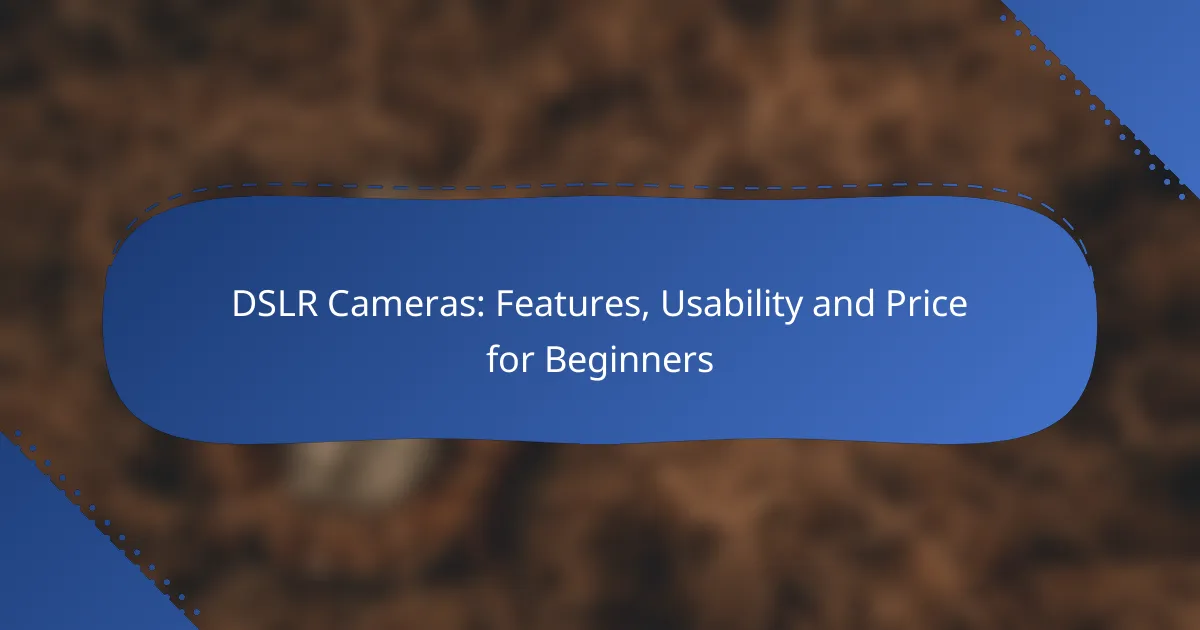For beginners venturing into photography, selecting the right DSLR camera is essential, as it should offer a blend of user-friendly features, affordability, and good image quality. Popular models like the Canon EOS Rebel T8i and Nikon D3500 provide intuitive controls and solid performance, making them ideal choices. Understanding key features such as image quality, autofocus performance, and lens compatibility can greatly enhance the overall shooting experience. Prices for beginner DSLRs typically range from $300 to over $1,000, reflecting the camera’s capabilities and functionalities.

What are the best DSLR cameras for beginners?
The best DSLR cameras for beginners combine user-friendly features, affordability, and good image quality. Options like the Canon EOS Rebel T8i and Nikon D3500 are popular choices that offer intuitive controls and solid performance.
Canon EOS Rebel T8i
The Canon EOS Rebel T8i is an excellent entry-level DSLR known for its ease of use and versatile features. It boasts a 24.1 MP sensor, which delivers sharp images, and a vari-angle touchscreen that simplifies shooting from different angles.
This camera includes built-in Wi-Fi and Bluetooth for easy sharing and remote control. With a price range typically between $800 and $900, it offers great value for beginners looking to explore photography without overwhelming complexity.
Nikon D3500
The Nikon D3500 is a compact and lightweight DSLR that is perfect for novice photographers. It features a 24.2 MP sensor and a user-friendly Guide Mode that helps users learn photography basics while shooting.
With a price point around $500 to $600, the D3500 is budget-friendly and offers excellent battery life, allowing for extended shooting sessions. Its robust build and image quality make it a solid choice for those starting their photography journey.
Canon EOS 90D
The Canon EOS 90D is a more advanced option for beginners who want to grow into their photography skills. It features a 32.5 MP sensor and impressive autofocus capabilities, making it suitable for various shooting scenarios, including action photography.
Priced between $1,200 and $1,400, it offers advanced features like 4K video recording and a high-resolution viewfinder. This camera is ideal for those willing to invest a bit more for enhanced performance and versatility.
Nikon D5600
The Nikon D5600 is a well-rounded DSLR that balances performance and usability for beginners. It has a 24.2 MP sensor and a touchscreen interface, making it easy to navigate settings and review images.
With a price range of approximately $700 to $800, the D5600 offers features like SnapBridge for seamless image sharing. Its combination of image quality and user-friendly design makes it a popular choice among new photographers.

How do DSLR camera features impact usability?
DSLR camera features significantly influence usability by determining how easily a beginner can take high-quality photos. Key aspects such as image quality, autofocus performance, and lens compatibility play crucial roles in the overall experience and effectiveness of the camera.
Image quality and sensor size
Image quality in DSLR cameras is largely determined by the sensor size, which affects the amount of light captured. Larger sensors, such as full-frame sensors, typically produce better images with less noise, especially in low-light conditions. Beginners should consider cameras with APS-C or full-frame sensors for improved image quality.
When selecting a camera, look for models that offer a good balance between sensor size and price. Full-frame cameras tend to be more expensive, while APS-C sensors are often more budget-friendly and still provide excellent image quality for most situations.
Autofocus performance
Autofocus performance is critical for capturing sharp images, especially in dynamic environments. DSLRs with advanced autofocus systems can quickly lock onto subjects, making them ideal for action shots or portraits. Beginners should look for cameras with multiple autofocus points and fast focusing speeds.
For practical use, consider cameras with phase-detection autofocus, which generally performs better in low light and when tracking moving subjects. A good autofocus system can make a significant difference in the ease of capturing clear images.
Lens compatibility
Lens compatibility is an important factor for DSLR usability, as it determines the range of photography styles a beginner can explore. Most DSLR brands offer a variety of lenses, from wide-angle to telephoto, allowing users to adapt to different shooting scenarios. Beginners should check the availability of lenses for their chosen camera system.
When selecting a camera, consider the ecosystem of lenses available. Some brands have extensive selections, while others may be limited. Investing in a camera with a robust lens lineup can enhance your photography experience and provide more creative options.

What is the price range for beginner DSLR cameras?
Beginner DSLR cameras typically range from around $300 to over $1,000, depending on features and brand. The price influences the camera’s capabilities, including image quality, lens options, and additional functionalities.
Entry-level models under $500
Entry-level DSLR cameras priced under $500 are ideal for beginners looking to explore photography without a significant investment. These models often include basic features, such as automatic shooting modes and built-in tutorials, making them user-friendly.
Popular options in this range include models like the Canon EOS Rebel T7 and Nikon D3500. They typically offer decent image quality and interchangeable lenses, allowing for some creative flexibility.
Mid-range models between $500 and $1000
Mid-range DSLR cameras priced between $500 and $1,000 provide enhanced features and better performance for aspiring photographers. These models often include larger sensors, faster autofocus systems, and improved low-light capabilities.
Examples include the Canon EOS 90D and Nikon D5600, which offer advanced shooting modes and higher resolution. This range is suitable for those who want to take their photography skills to the next level without breaking the bank.
High-end models over $1000
High-end DSLR cameras priced over $1,000 are designed for serious enthusiasts and professionals. These cameras typically feature superior build quality, advanced autofocus systems, and exceptional image sensors that deliver outstanding performance in various conditions.
Models like the Canon EOS 6D Mark II and Nikon D7500 are examples of this category, offering extensive customization options and high-speed shooting capabilities. Investing in a high-end model can significantly enhance your photography experience and results.

What features should beginners prioritize in a DSLR?
Beginners should focus on features that enhance usability and learning, such as an intuitive interface, lightweight design, and decent battery life. These aspects make it easier to handle the camera and improve the overall photography experience.
Ease of use and interface
An easy-to-navigate interface is crucial for beginners. Look for cameras with clearly labeled buttons and a straightforward menu system, which can significantly reduce the learning curve. Touchscreen functionality can also enhance usability, allowing for quick adjustments and settings changes.
Consider models with guided modes or tutorials built into the camera. These features can help beginners understand different shooting modes and settings, making the transition from automatic to manual shooting smoother.
Weight and portability
Weight and portability are essential for beginners who may not be accustomed to carrying heavy equipment. A lightweight DSLR, typically weighing between 400 to 800 grams, is easier to handle and transport, especially during long shooting sessions.
When selecting a camera, consider the size and compatibility with different lenses. A compact design allows for easier storage and travel, making it more likely that you’ll take your camera along for spontaneous photography opportunities.
Battery life
Battery life is a key consideration for beginners, as it affects how long you can shoot without interruption. Most entry-level DSLRs offer battery life ranging from 400 to 800 shots per charge, which is generally sufficient for a day of shooting.
To maximize battery performance, turn off features like Wi-Fi and GPS when not in use, and keep an eye on your LCD screen usage. Carrying a spare battery can also be a smart move, especially for day trips or events where charging may not be possible.

How to choose the right DSLR camera for your needs?
Choosing the right DSLR camera involves understanding your photography goals, budget, and the features that matter most to you. Consider factors like image quality, ease of use, and available lenses to find a camera that fits your needs.
Assessing photography goals
Start by identifying what you want to achieve with your photography. Are you interested in landscapes, portraits, or action shots? Each type of photography may require different features, such as lens compatibility and autofocus capabilities.
For instance, if you plan to shoot sports or wildlife, look for a camera with fast autofocus and a high frame rate. Conversely, for portrait photography, a camera with good low-light performance and the ability to use a variety of lenses will be beneficial.
Additionally, consider whether you want to shoot in manual mode or prefer automatic settings. Beginners might benefit from a camera that offers a guided mode, while more experienced photographers may want full manual control to experiment with settings.
